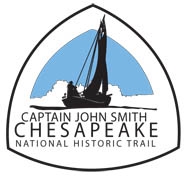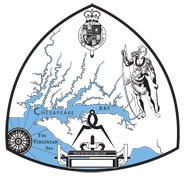CJS - Elk Neck State Park Traditional Geocache
CJS - Elk Neck State Park
-
Difficulty:
-

-
Terrain:
-

Size:  (regular)
(regular)
Please note Use of geocaching.com services is subject to the terms and conditions
in our disclaimer.


Come on a journey to remember and commemorate the history and travels of Captain John Smith!
Over four hundred years ago, Englishman John Smith and a small crew set out in an open boat to explore the Chesapeake Bay. Between 1607 and 1609 Smith mapped and documented nearly 3,000 miles of the Bay and its rivers. Along the way he visited many thriving American Indians communities and gathered information about this “fruitful and delightsome land.” In December 2006 the U.S. Congress designated the routes of Smith’s explorations of the Chesapeake as a national historic trail—the first national water trail.
Are you ready to follow in the wake of Captain John Smith? Visit sites along the National Historic Trail and learn about the native cultures and the natural environment of the 17th-century Chesapeake through the Captain John Smith Chesapeake Geotrail. The Trail provides opportunities for you to experience the Bay through the routes and places associated with Smith’s explorations. Caches will be located in museums, refuges, parks, and towns in Virginia, Maryland and Delaware along the rivers and creeks that Smith and his crew explored four centuries ago.
The Captain John Smith (CJS) Geotrail launched June 4, 2011 with over 40 caches within Maryland, Virginia and Delaware. A trackable geo coin will be awarded to the first 400 geocachers, while supplies last, for locating at least 15 CJS caches. To be eligible for the coin, geocachers must download a passport from either the CJS Geotrail or Maryland Geocaching Society website. Geocachers must find and log at least 15 finds, record the code word from each cache on their passport and post a picture of themselve at each cache location. After discovering the 15 required caches, geocachers may have thier passports validated in person or via mail at the National Park Service, Chesapeake Bay Office located at 410 Severn Ave, Suite 314, Annapolis, MD 21403. Please refer to the passport for complete validation instructions.
Participating in the CJS geotrail is fun and we hope that many people join in. However, it is not a requirement for logging your find on this cache once you find the container.
You are seeking a traditional hide located off of the blue trail. This section of the park does allow hunting so please use caution during hunting season and wear blaze orange. Please no night caching and adhere to all park rules.
Elk Neck is your year-round, travel destination to connect with the vast landscapes and waters of the Chesapeake Bay. As a result, there are several journeys you can take while in the park.
 Elk Neck State Park features more than 2,100 acres of sandy beaches, marshlands and heavily wooded bluffs overlooking the North East River, the Elk River and the Chesapeake Bay. One of the Elk Neck’s most popular attractions is Turkey Point Lighthouse, a signature landmark of the park dating from 1833. If you want to visit the lighthouse, plan to come on a Saturday or Sunday between April and November from 10am and 4pm. On these days, you can climb up to the top of the 35 foot tall structure and learn more about its history and uses from one of the park’s dedicated volunteers.
Elk Neck State Park features more than 2,100 acres of sandy beaches, marshlands and heavily wooded bluffs overlooking the North East River, the Elk River and the Chesapeake Bay. One of the Elk Neck’s most popular attractions is Turkey Point Lighthouse, a signature landmark of the park dating from 1833. If you want to visit the lighthouse, plan to come on a Saturday or Sunday between April and November from 10am and 4pm. On these days, you can climb up to the top of the 35 foot tall structure and learn more about its history and uses from one of the park’s dedicated volunteers.
Elk Neck also offers extensive public access to the water. The boat launch facility at Rogues Harbor is a popular destination for journeys exploring the Elk River, Bohemia River, Sassafras River and the Bay. For access to the North East River and Susquehanna Flats, launch from the North East River Area. In addition, the park also has 12 scenic miles of trails that offer opportunities to view wildlife, including eagles, hawks, beaver, white-tailed deer, groundhogs, fox, raccoon, river otter, squirrel, skunk, and opossum.
In 1608, as John Smith approached the area now home to Elk Neck State Park, he was looking for a water passage across North America that would take him to the Pacific Ocean and then onto China. He was also looking for gold and silver, which in addition to the water passage, would aid the British in their ongoing competition with European rival and fellow colonial power Spain for control of lands in the Americas.
In the end, Smith found neither, but at the “head of the bay” he encountered rich and diverse American Indian cultures as well as a natural environment teeming with aquatic life, including oysters, crabs and fish. Huge flocks of birds also made use of the “Atlantic Flyway” that passes over this area, darkening the sky with their enormous numbers. Huge stands of submerged aquatic vegetation or “SAV” also flourished in this region. These important grasses catch sediment and provide food to a host of species.
In 1608, two major Native language families were represented in this region – Algonquian and Iroquoian. Among the Iroquoian-speaking groups were the Susquehannocks, who lived up the Susquehanna River and the Massawomecks, another Iroquoian-speaking people who were rivals to the Susquehannocks and whose home base possibly lay some miles up the Potomac River.
In late July and early August 1608, Smith explored the rivers that surround Elk Neck State Park including the Elk, North East and Sassafras. According to his writings, the crew encountered seven or eight canoes of Massawomecks near the mouth of the Sassafras on July 31. Though initially Smith feared a hostile encounter, the two groups engaged in trading and questioning but no fighting. The following day, Smith and his crew passed a village inhabited by the Tockwoghs, an Algonquian-speaking people who lived along the Sassafras. Enemies of the Massawomecks, the Tockwoghs were allied with the Susquehannocks, who, through trade, had provided them with iron cutting tools and pieces of brass. This interested Smith, who, with the aid of bilingual Tockwoghs decided to seek out the Susquehannocks later in his voyage.
 Thanks to MomMom & PopPop for helping with this hide and to the Maryland Geocaching Society for assisting with this project!
Thanks to MomMom & PopPop for helping with this hide and to the Maryland Geocaching Society for assisting with this project!
Additional Hints
(Decrypt)
Ybbx ng cubgb sebz ybt ba 6/24/17 gb uryc jvgu lbhe frnepu. Ab ybatre n erthyne fvmr pbagnvare.